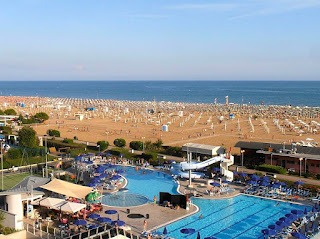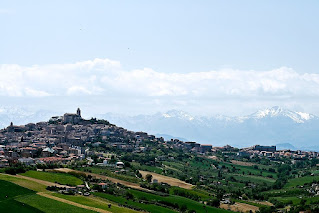One half of popular duo Paola e Chiara
 |
| Chiara Iezzi has enjoyed success both as a singer and in tv and film roles |
The sisters performed together for seven years between 1996 and 2013, selling more than five million records, before breaking up, Chiara deciding to focus increasingly on acting and enjoying some success in the United States.
The duo were reunited in 2023, when they took part in the Sanremo Music Festival for the sixth time, having made their debut at the celebrated Italian song contest 26 years earlier.
Interested in music, acting and fashion since she was in her teens, Chiara graduated in fashion design, simultaneously taking acting lessons, but it was music that initially provided her with a career.
After seeing her perform in jazz and funk groups, in 1994 the record producer and television presenter Claudio Cecchetto hired her together with Paola to join singer Max Pezzali as backing vocalists in a group called 883, who were popular in Milan in the 1990s.
 |
| Paola (left) and Chiara with the trophy they won at the Sanremo Music Festival in 1997 |
The following year, they entered Sanremo proper, performing the song Amici come prima, with which they won the New Proposals category.
The song featured on their debut studio album for Sony, Ciriamo Bambine, which would be the first of eight studio albums. They also released three collections of hits and 35 singles, the most successful of which was Vamos a bailar (Esta vida nueva), sung in Spanish and released in 2000.
Performing Vamos a bailar, which featured on their album Television, they won two song contests, Festivalbar and Un disco per l'estate. The single contributed substantially to their more than five million records sold.
Alongside her career with Paola, Chiara released a number of singles and EPs as a solo performer before turning her attention increasingly to acting, her ambitions not at all harmed by being invited in 2010 to collaborate on the soundtrack of the film Maledimiele, directed by Marco Pozzi, for which she sang the main theme, L'altra parte di me.
 |
| Chiara Iezzi starred in the Disney Channel television series Alex & Co in 2015 |
She had a number of successes in acting, notably playing the role of Victoria Williams in the 2015 TV series Alex & Co, produced by Disney Channel.
In 2016, she landed a role in the film Il ragazzo della Giudecca (The Boy from the Giudecca), directed by Alfonso Bergamo and starring Giancarlo Giannini and Franco Nero, and in 2017 was picked for Louis Nero's film The Broken Key alongside Rutger Hauer, William Baldwin, Geraldine Chaplin and Michael Madsen.
The possibility that she and her sister might reform their partnership arose in 2022. Chiara appeared at a DJ set hosted by her sister, for whom deejaying had become the focus of her career, and they surprised the audience by performing a number of their songs together. The clip of their performance was downloaded so many times it became a viral hit, after which they agreed to make an appearance as guests at a concert in Bibione, on the Adriatic coast of the Veneto, which was part of a Max Pezzali tour, and alongside Jovanotti at Fermo, further down the Adriatic in Marche.
They were so well received by the audiences that talk of a Paola e Chiara revival soon gathered pace. In December of the same year it was announced that they would participate in the 2023 edition of the Sanremo Festival, their first appearance there for 15 years.
Their song, Furore, finished only 17th, yet was a hit nonetheless, prompting them to embark on a first tour in 12 years and to release their first album since 2015, a reworked collection of their best work entitled Per Sempre (Forever).
The duo returned to Sanremo in 2024 as guests, reprising Furore on the third evening and performing alongside veteran entrants Ricchi e Poveri on the fourth evening, as well as presenting some of the accompanying broadcasts as national TV channel Rai dedicated hours of airtime to the festival and peripheral activities.
 |
| Bibione's wide expanse of golden, sandy beach makes it an attraction for thousands of tourists |
Bibione, where Paola e Chiara reunited alongside former professional partner Max Pezzali at a 2022 concert, is a seaside resort in the Veneto region of northern Italy, about 50km (31 miles) from Venice as the crow flies, although about twice that distance by road. It is a popular destination for tourists from Germany, Austria, Czech Republic, and Slovakia, as well as Italy, who enjoy its golden sand beach, pine wood, and water park. The area used to be uninhabited marshland until land reclamation work began in the early part of the 20th century and it was not until the 1950s that the first holiday accommodation was built. Nowadays, in the summer months, Bibione can offer up to 100,000 beds for tourists, yet in the winter is largely deserted, with many shops and beach facilities closed.
Stay in Bibione with Booking.com
 |
| Fermo sits atop the Sabulo hill, the cathedral of Santa Maria Assunta in Cielo at its highest point |
Fermo, where Paola e Chaira performed at a Jovanotti concert in 2022, is a charming and lively town in the Marche region, with a population of about 37,000. It is located on a hill, the Sabulo, some 319m (1,050ft) above sea level, about 7km (4.34 miles) inland from the Adriatic resort of Porto San Giorgio. A former Roman colony, it was owned by a succession of prince-bishops and powerful families, including the Visconti and Sforza, before becoming part of the Papal States in 1550, all of whom contributed to its impressive monuments, buildings and fortifications. The Roman cisterns, the 13th century cathedral of Santa Maria Assunta in Cielo, the Palazzo dei Priori, built between the 13th and 16th centuries, the Pinacoteca Civica and the Teatro dell’Aquila are among its noteworthy attractions. The town hosts diverse cultural events, from an August palio (horse race) and festival of mediaeval games, the Cavalcata dell’Assunta, to an annual film festival. The town is also famed for its culinary specialities, which include a type of lasagna with meat sauce, olives, and cheese, called vincisgrassi, a fish soup with tomatoes, saffron, and vinegar known as brodetto, and frustingo, a cake made with dried fruits, nuts, honey, and chocolate.
Find accommodation in Fermo with Booking.com
More reading:
The history of the Sanremo Music Festival
The singer whose Sanremo disqualification produced his biggest hit
The tenor who became known as ‘the King of Sanremo’
Also on this day:
1950: The birth of fashion designer Franco Moschino
1935: The birth of opera singer Mirella Freni
1964: Italy appeals for help to save Pisa’s leaning tower
1978: The birth of dancer Simone Di Pasquale
(Picture credits: Bibione beach by Tiesse; Fermo skyline by Daniele Pieroni; via Wikimedia Commons)
.jpg)




.jpg)






.jpg)
.jpg)
.jpg)

.jpg)
